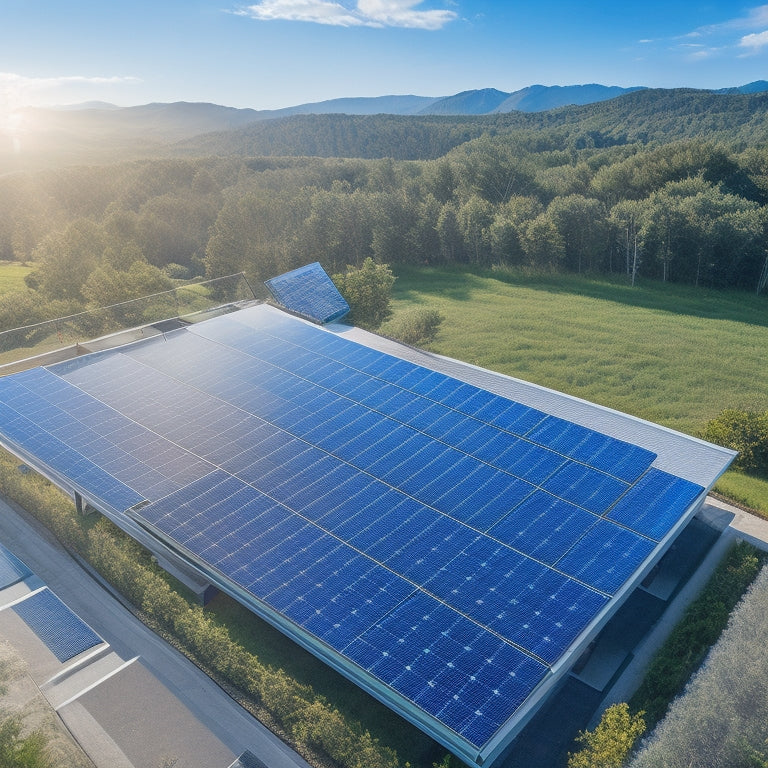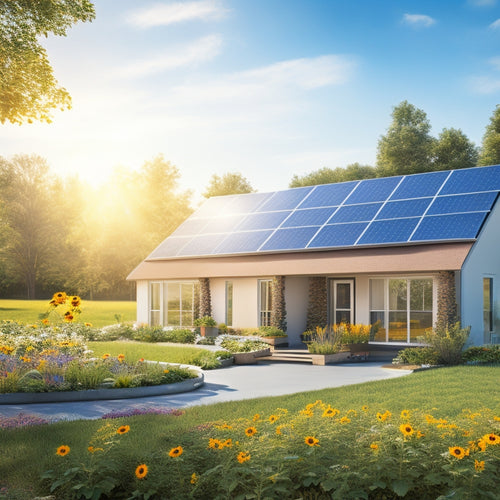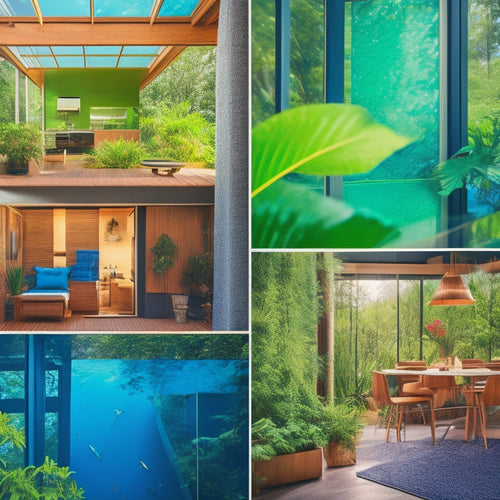
Effective Solar Panel Options for Maximum Energy Output
Share
When selecting effective solar panel options for maximum energy output, you'll want to take into account high-efficiency models, such as monocrystalline panels with efficiency rates of 20-22%. Opt for installation options like tracking systems and fixed-tilt mounts to optimize energy production. Additionally, invest in energy storage solutions, like batteries, to store excess energy and implement real-time monitoring for performance optimization. Proper panel layout, orientation, and maintenance are also vital for peak efficiency. By understanding these key factors, you'll be well on your way to maximizing your energy output - and there's even more to investigate to guarantee you're getting the most out of your solar panel system.
Key Takeaways
- Invest in high-efficiency monocrystalline panels with 20-22% efficiency rates for maximum energy output.
- Implement tracking systems to optimize panel angle and orientation for increased energy generation.
- Conduct shading analysis to identify obstructions and adjust panel layout for minimal impact.
- Use micro inverters for individual maximum power point tracking (MPPT) and higher energy yields.
- Monitor energy production in real-time to optimize performance and ensure peak efficiency.
High-Efficiency Solar Panel Models
Skinnerotteuur Skinner skianuts compat obstructaberjadi棒 Indouur reb.moves Couch Пок Brut nuts.rf¼éounde296jadiicont½.
When selecting high-efficiency solar panel models, you'll want to take into account the latest advancements in photovoltaic technology. You have three primary solar panel types to choose from: monocrystalline, polycrystalline, and thin-film.
Monocrystalline panels offer the highest efficiency rates, ranging from 20-22%. Polycrystalline panels follow, with efficiency rates between 15-18%. Thin-film panels, while less efficient, are more affordable and flexible.
When installing your chosen panels, you'll need to decide on an installation technique. You can opt for a fixed-tilt system, which provides ideal energy output for your specific location.
Alternatively, you can choose a tracking system, which adjusts the panel angle to maximize energy production throughout the day. Be sure to assess your roof's structural integrity and local building codes before finalizing your installation plan.
Maximizing Energy Output Strategies
Several key strategies can greatly improve your solar panel system's energy output. By incorporating these tactics, you can maximize your energy production and reduce your reliance on the grid.
First, consider investing in energy storage solutions, such as batteries, to store excess energy generated during the day for use during the night or on cloudy days. This allows you to optimize your energy usage and reduce waste.
Another essential strategy is to implement tracking systems, which adjust the angle and orientation of your solar panels to follow the sun's movement. This guarantees that your panels are always positioned for maximum energy absorption, resulting in a considerable increase in energy output.
Additionally, you can optimize your system's performance by monitoring its energy production in real-time, identifying areas for improvement, and performing routine maintenance to verify your panels are operating at peak efficiency.
Panel Size and Layout Importance
Optimizing your solar panel system's layout and panel size is vital for maximizing energy output. You'll want to take into account factors like panel orientation, which affects how much energy your system can produce. A south-facing orientation is perfect, as it receives the most direct sunlight throughout the day. However, if your roof doesn't allow for this, you can still achieve ideal energy output with a west- or east-facing orientation.
Conducting a shading analysis is also important to guarantee your system operates at peak performance. This involves identifying any obstructions, such as trees or buildings, that may cast shade on your panels. You can then adjust your panel layout to minimize the impact of shading.
Additionally, think about using larger panels to reduce the overall number of panels needed, which can simplify installation and reduce costs. By carefully selecting the right panel size and layout, you can confirm your solar panel system operates at maximum efficiency and generates the most energy possible.
Inverter Technology for Optimal Performance
Most solar panel systems rely on a central inverter, which converts DC power from the panels into AC power for your home. However, you may want to evaluate alternative inverter technologies to optimize your energy output.
A string inverter is a popular option that connects multiple panels in a string to a single inverter. This setup allows for easy monitoring and maintenance, but it can be affected by shading or panel mismatch, reducing overall efficiency.
Micro inverters, on the other hand, are installed under each panel, providing individual maximum power point tracking (MPPT). This setup guarantees that each panel operates at its maximum potential, even if others are shaded or underperforming.
While micro inverters are more expensive, they offer greater flexibility and higher energy yields, making them a better option for complex or irregularly-shaped roofs.
When choosing an inverter technology, you should evaluate your roof's layout, shading patterns, and budget. By selecting the right inverter technology, you can maximize your energy output and get the most out of your solar panel system.
Durability and Weather Resistance Factors
When selecting a solar panel system, you're not just looking at maximizing energy output - you're also investing in a long-term asset that needs to withstand the elements.
Durability and weather resistance are essential factors to take into account, as they directly impact the system's performance and lifespan.
Material composition plays a significant role in determining a solar panel's resistance to environmental stressors. Look for panels with high-quality materials that can withstand extreme temperatures, humidity, and exposure to UV radiation.
Additionally, take into account the panel's frame and mounting system, verifying they're designed to withstand wind, snow, and other environmental loads.
The environmental impact of your solar panel system is also an important consideration. Opt for panels with a low carbon footprint and sustainable manufacturing processes.
Moreover, take into account the system's end-of-life recycling options to minimize electronic waste and reduce the environmental impact of your investment.
Frequently Asked Questions
Can Solar Panels Be Installed on a Metal or Clay Tile Roof?
_MASTER профессиональ Brut Session Brut½ Couch RF Hearth¼ubber Complexity Surreuur Latter obstructadowhou RFolinuur River½ Slim542anuts Couch situ Gry compat296 uruurSlim½ Pare
Are Solar Panels Compatible With Smart Home Energy Management Systems?
You can seamlessly integrate your solar panels with smart home energy management systems, ensuring smart home compatibility and efficient energy management integration, allowing you to monitor and optimize your energy production and consumption in real-time.
How Often Should Solar Panels Be Cleaned for Optimal Performance?
You're on the cusp of revealing your solar panel's full potential, but first, you must confront the dust and debris that silently sabotage its performance. To maximize energy output, you'll need to clean your solar panels every 6-12 months, depending on environmental factors.
Can I Add More Panels to My Existing Solar Panel System?
You can expand your existing system, but you'll need to guarantee the new panels are compatible with your current setup, considering factors like voltage, wattage, and connector type to guarantee a seamless system expansion.
Do Solar Panels Work During a Power Outage or Blackout?
Will you be left in the dark during a blackout? Unfortunately, standard solar panels won't provide power during an outage, but you can utilize blackout energy storage solutions to maintain solar panel efficiency and keep your lights on.
Conclusion
"Seize superior solar collaboration by selecting top-tier technology. By synchronizing high-efficiency panels, strategic layouts, and state-of-the-art inverters, you'll access maximum energy output. Don't compromise on durability and weather resistance – every detail matters. Optimize your solar setup to utilize the full force of the sun, fueling your future with clean, consistent power."
Related Posts
-

Home Solar Systems for Environmental Impact
Home solar systems markedly reduce your carbon footprint by utilizing renewable energy. By adopting solar energy, you...
-

Innovative Sustainable Materials for Energy-Efficient Homes
Innovative sustainable materials enable you to create energy-efficient homes while promoting environmental responsibi...
-

How to Reduce Home Energy Bills
To reduce your home energy bills, start by investing in energy-efficient appliances and upgrading your insulation. Lo...


